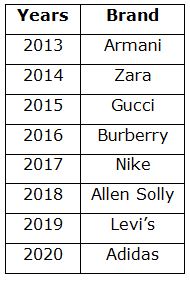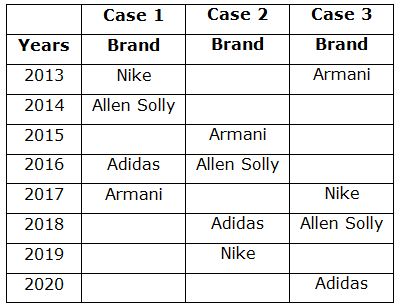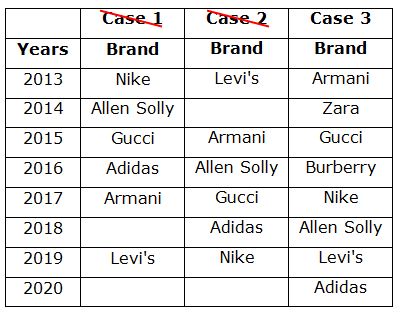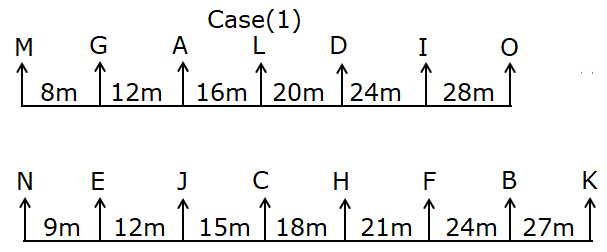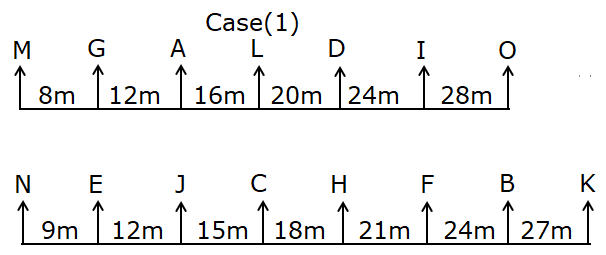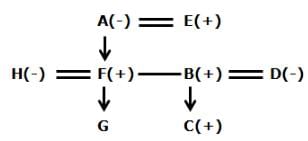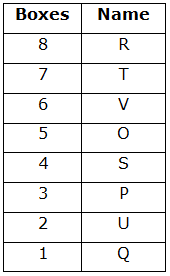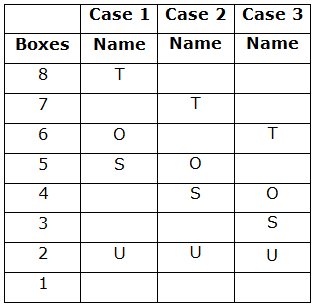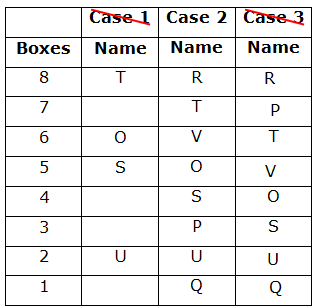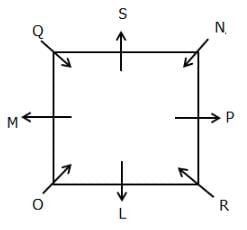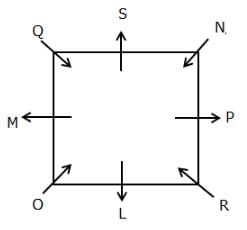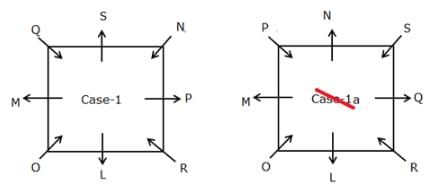IDBI Assistant Manager Mock Test - 1 - Bank Exams MCQ
30 Questions MCQ Test IDBI Assistant Manager Mock Test Series 2025 - IDBI Assistant Manager Mock Test - 1
Study the following information carefully and answer the questions given below.
Eight different clothing brands viz. Adidas, Allen Solly, Armani, Burberry, Gucci, Levi’s, Nike, and Zara are launched their clothes in different years from 2013 to 2020, but not necessarily in the same order.
Allen Solly launched in an even numbered year and two years before Adidas launches. The number of clothes launched after Adidas is the same as before Armani. Only three years are there between Armani and Nike. Gucci launched exactly between Armani and Nike. Levi's launched in an odd numbered year but neither adjacent to Burberry nor Zara, which is launched before Burberry.
Q. Which of the following brand launched in the year 2016?
Eight different clothing brands viz. Adidas, Allen Solly, Armani, Burberry, Gucci, Levi’s, Nike, and Zara are launched their clothes in different years from 2013 to 2020, but not necessarily in the same order.
Allen Solly launched in an even numbered year and two years before Adidas launches. The number of clothes launched after Adidas is the same as before Armani. Only three years are there between Armani and Nike. Gucci launched exactly between Armani and Nike. Levi's launched in an odd numbered year but neither adjacent to Burberry nor Zara, which is launched before Burberry.
Study the following information carefully and answer the questions given below.
Eight different clothing brands viz. Adidas, Allen Solly, Armani, Burberry, Gucci, Levi’s, Nike, and Zara are launched their clothes in different years from 2013 to 2020, but not necessarily in the same order.
Allen Solly launched in an even numbered year and two years before Adidas launches. The number of clothes launched after Adidas is the same as before Armani. Only three years are there between Armani and Nike. Gucci launched exactly between Armani and Nike. Levi's launched in an odd numbered year but neither adjacent to Burberry nor Zara, which is launched before Burberry.
Q. How many years are there between the launch of Burberry and Levi's?
Eight different clothing brands viz. Adidas, Allen Solly, Armani, Burberry, Gucci, Levi’s, Nike, and Zara are launched their clothes in different years from 2013 to 2020, but not necessarily in the same order.
Allen Solly launched in an even numbered year and two years before Adidas launches. The number of clothes launched after Adidas is the same as before Armani. Only three years are there between Armani and Nike. Gucci launched exactly between Armani and Nike. Levi's launched in an odd numbered year but neither adjacent to Burberry nor Zara, which is launched before Burberry.
Study the following information carefully and answer the questions given below.
Eight different clothing brands viz. Adidas, Allen Solly, Armani, Burberry, Gucci, Levi’s, Nike, and Zara are launched their clothes in different years from 2013 to 2020, but not necessarily in the same order.
Allen Solly launched in an even numbered year and two years before Adidas launches. The number of clothes launched after Adidas is the same as before Armani. Only three years are there between Armani and Nike. Gucci launched exactly between Armani and Nike. Levi's launched in an odd numbered year but neither adjacent to Burberry nor Zara, which is launched before Burberry.
Q. If Zara is related to Nike and Burberry is related to Levi's in a certain way, then which of the following brand is related to Allen Solly?
Eight different clothing brands viz. Adidas, Allen Solly, Armani, Burberry, Gucci, Levi’s, Nike, and Zara are launched their clothes in different years from 2013 to 2020, but not necessarily in the same order.
Allen Solly launched in an even numbered year and two years before Adidas launches. The number of clothes launched after Adidas is the same as before Armani. Only three years are there between Armani and Nike. Gucci launched exactly between Armani and Nike. Levi's launched in an odd numbered year but neither adjacent to Burberry nor Zara, which is launched before Burberry.
In each of the following questions, the relationship between different elements is shown in the statements followed by three conclusions. Find the conclusion which logically follows.
Statements:
K ≥ P < R < Z; V < X ≤ K; V ≥ B=C
Conclusions:
I. C ≤ Z
II. V < K
III. P > Z
In each of the following questions, the relationship between different elements is shown in the statements followed by three conclusions. Find the conclusion which logically follows.
Statements:
D ≤ N < R < W; T > Y ≥ Z < D; J < G < T
Conclusions:
I. G < W
II. T < R
III. Y > N
Study the following information carefully and answer the following questions.
Fifteen persons from A to O are sitting in two parallel rows viz. Row 1 and Row 2 where the persons in both the row are facing towards north. Eight persons are sitting in row 2 and seven persons are sitting in row 1. Row 1 is to the north of row 2. The distance between the adjacent persons in row 1 is a consecutive multiple of 4 whereas the distance between the adjacent persons in row 2 is a consecutive multiple of 3 both from the left end and their distances are in meter. The distance between none of the adjacent persons is more than 30m.
Note: If the number of persons sitting to the left of both A and B is the same, then that means A is exactly in front of B. The consecutive alphabetically named persons are not sitting adjacent to each other.
E sits 45m to the left of H, but none of them sits at the ends. The person sitting in front of H sits to the immediate right of L. G sits 48m to the left of D. The number of persons sitting to the left of G is one less than the number of persons sitting to the right of F, who sits adjacent to H. D sits second to the right of A. F sits third to the right of J, who sits 21m away from N. At least two persons are sitting between N and F. Three persons are sitting between C and K, who sits adjacent to B. I sits to the immediate left of O.
Q. The distance between who among the following pair of persons is more than 25m?
I. CE
II. MA
III. LD
Study the following information carefully and answer the following questions.
Fifteen persons from A to O are sitting in two parallel rows viz. Row 1 and Row 2 where the persons in both the row are facing towards north. Eight persons are sitting in row 2 and seven persons are sitting in row 1. Row 1 is to the north of row 2. The distance between the adjacent persons in row 1 is a consecutive multiple of 4 whereas the distance between the adjacent persons in row 2 is a consecutive multiple of 3 both from the left end and their distances are in meter. The distance between none of the adjacent persons is more than 30m.
Note: If the number of persons sitting to the left of both A and B is the same, then that means A is exactly in front of B. The consecutive alphabetically named persons are not sitting adjacent to each other.
E sits 45m to the left of H, but none of them sits at the ends. The person sitting in front of H sits to the immediate right of L. G sits 48m to the left of D. The number of persons sitting to the left of G is one less than the number of persons sitting to the right of F, who sits adjacent to H. D sits second to the right of A. F sits third to the right of J, who sits 21m away from N. At least two persons are sitting between N and F. Three persons are sitting between C and K, who sits adjacent to B. I sits to the immediate left of O.
Q. Which of the following statement is/are not true with respect to the final arrangement?
Study the following information carefully and answer the questions given below.
A is the mother of B, who is the husband of D. F is the brother of the parent of C. D is the daughter-in-law of E and has no siblings. C is the son of D. H is the mother of G and is the sister-in-law of B.
Q. How G is related to B?
Study the following information carefully and answer the questions given below.
A is the mother of B, who is the husband of D. F is the brother of the parent of C. D is the daughter-in-law of E and has no siblings. C is the son of D. H is the mother of G and is the sister-in-law of B.
Q. How A is related to C?
Study the following information carefully and answer the questions given below.
Eight boxes viz. O, P, Q, R, S, T, U, and V are kept one above the other on a stack. The bottom-most box is numbered as 1 and the topmost box is numbered as 8. The consecutive alphabetically named boxes are not kept adjacent to each other.
Not more than two boxes are kept above box T, which is kept two boxes above box O. Box S is kept adjacent to box O. Only one box is kept below box U.The number of boxes kept below box U is one more than the boxes kept above box R. Less than two boxes are kept between boxes S and P which is not kept on the bottommost box.
Q. Four of the following five are alike in a certain way and hence form a group. Find the one that doesn’t belong to that group?
Study the following information carefully and answer the questions given below.
Eight boxes viz. O, P, Q, R, S, T, U, and V are kept one above the other on a stack. The bottom-most box is numbered as 1 and the topmost box is numbered as 8. The consecutive alphabetically named boxes are not kept adjacent to each other.
Not more than two boxes are kept above box T, which is kept two boxes above box O. Box S is kept adjacent to box O. Only one box is kept below box U.The number of boxes kept below box U is one more than the boxes kept above box R. Less than two boxes are kept between boxes S and P which is not kept on the bottommost box.
Q. What is the position of box P with respect to box O?
Read the given passage carefully and answer the questions that follow:
In line with the trends in the broader economy, the Centre’s tax revenues have been growing at a brisk pace. At the aggregate level, the Centre’s gross tax revenues in the first seven months (April to October) of the current financial year were up 56 per cent over the same period last year, as per data released by the Controller General of Accounts. While these numbers are skewed owing to the low base effect, tax collections were 30 per cent higher than over the same period in 2019.
Q. Which of the following can be inferred from the facts given in the statement above?
Read the given passage carefully and answer the questions that follow:
In line with the trends in the broader economy, the Centre’s tax revenues have been growing at a brisk pace. At the aggregate level, the Centre’s gross tax revenues in the first seven months (April to October) of the current financial year were up 56 per cent over the same period last year, as per data released by the Controller General of Accounts. While these numbers are skewed owing to the low base effect, tax collections were 30 per cent higher than over the same period in 2019.
Q. Statements:
A. The banks have decided to provide loans to the SMEs at the same interest rates as the corporates
B. The banks have been facing the issue of bad loans and have decided to provide lesser number of educational loans
Study the following information carefully and answer the below questions.
Eight persons- L, M, N, O, P, Q, R and S are sitting on the square table in such a way that four of them sit on the corner faces the centre whereas four of them sit in the middle of the table face outside the centre but not necessarily in the same order.
M sits third to the left of R who sits on the corner of the table. Only one person sits between R and O. N sits immediate left of P and vice versa. The number of persons sits between N and R is the same as the number of persons sit between O and Q when counted from the right of both R and Q. N neither sits adjacent to R nor opposite to R. The number of persons sits between S and P is the same as the number of persons sits between L and P. L and N are not immediate neighbours.
Q. Who among the following person sits opposite to O?
Study the following information carefully and answer the below questions.
Eight persons- L, M, N, O, P, Q, R and S are sitting on the square table in such a way that four of them sit on the corner faces the centre whereas four of them sit in the middle of the table face outside the centre but not necessarily in the same order.
M sits third to the left of R who sits on the corner of the table. Only one person sits between R and O. N sits immediate left of P and vice versa. The number of persons sits between N and R is the same as the number of persons sit between O and Q when counted from the right of both R and Q. N neither sits adjacent to R nor opposite to R. The number of persons sits between S and P is the same as the number of persons sits between L and P. L and N are not immediate neighbours.
Q. Who among the following person does not sit in the middle of the table?
Study the following information carefully and answer the below questions.
Eight persons- L, M, N, O, P, Q, R and S are sitting on the square table in such a way that four of them sit on the corner faces the centre whereas four of them sit in the middle of the table face outside the centre but not necessarily in the same order.
M sits third to the left of R who sits on the corner of the table. Only one person sits between R and O. N sits immediate left of P and vice versa. The number of persons sits between N and R is the same as the number of persons sit between O and Q when counted from the right of both R and Q. N neither sits adjacent to R nor opposite to R. The number of persons sits between S and P is the same as the number of persons sits between L and P. L and N are not immediate neighbours.
Q. Which of the following statement is/are true?
I. S sits opposite to O
II. R and S are facing the same direction
III. L faces outside the centre
Study the following information carefully and answer the questions given below.
A numerical machine, when given an input, performs certain logic on each step and arrives at the final step. The following is the illustration of the input and its steps.
Input: 53 49 62 86 37 24 71 93 78 42
Step 1: 86 53 49 62 37 24 71 78 42 93
Step 2: 86 78 53 49 62 37 24 42 71 93
Step 3: 86 78 62 49 37 24 42 53 71 93
Step 4: 86 78 62 42 37 24 49 53 71 93
Step 5: 86 78 62 42 24 37 49 53 71 93
Step 5 is the last and final step of the given input. Following the same logic, find the steps and final output of the input given below.
Input: 85 96 19 36 28 73 57 48 31 82
Q. In which of the following step the numbers “36 19 28” present in the same order?
Study the following information carefully and answer the questions given below.
A numerical machine, when given an input, performs certain logic on each step and arrives at the final step. The following is the illustration of the input and its steps.
Input: 53 49 62 86 37 24 71 93 78 42
Step 1: 86 53 49 62 37 24 71 78 42 93
Step 2: 86 78 53 49 62 37 24 42 71 93
Step 3: 86 78 62 49 37 24 42 53 71 93
Step 4: 86 78 62 42 37 24 49 53 71 93
Step 5: 86 78 62 42 24 37 49 53 71 93
Step 5 is the last and final step of the given input. Following the same logic, find the steps and final output of the input given below.
Input: 85 96 19 36 28 73 57 48 31 82
Q. Find the difference between the highest number and the fourth number from the right in the final step of the given input.
Study the following information carefully and answer the questions given below.
The given bar graph shows the average of the number of girls and the number of students who like French and the number of girls in five different schools.
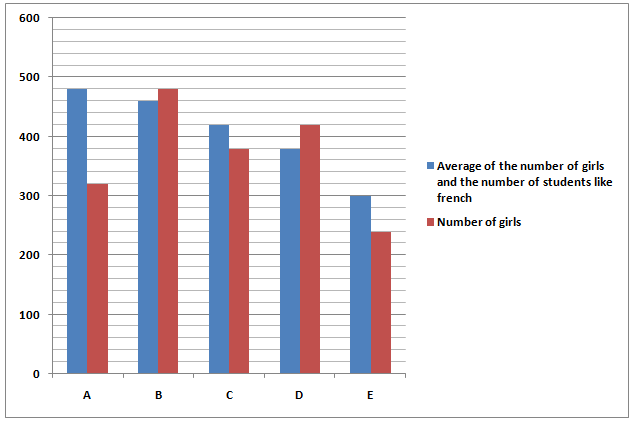
The given table shows the number of students like German in those different schools.
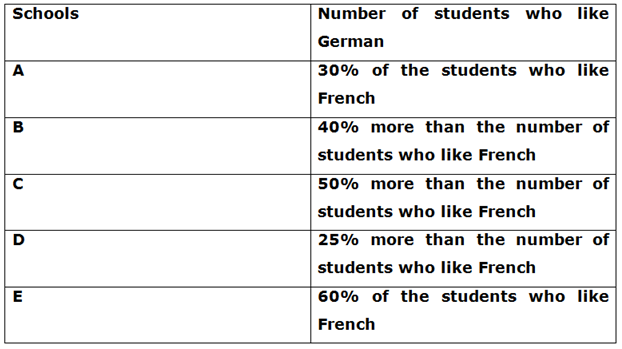
Note: French and German language only teaches to those school students.
Q. The number of girls in A and D together is what percent of the number of students who like French in C and D together?
Study the following information carefully and answer the questions given below.
The given bar graph shows the average of the number of girls and the number of students who like French and the number of girls in five different schools.

The given table shows the number of students like German in those different schools.

Note: French and German language only teaches to those school students.
Q. What is the ratio of the number of girls in C and D together to the number of boys in A and C together?
Study the following information carefully and answer the questions.
The given pie chart shows the percentage distribution of the total income of the five different persons i.e. P, Q, R, S and T in March.
Income=Expenditure + Savings
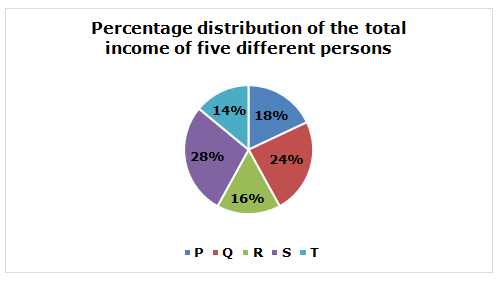
Note: Difference between the income of Q and T is Rs.5000.
Q. If all the person’s expenditure and savings ratio is 4:1, then the savings of P is what percentage of the income of Q?
Study the following information carefully and answer the questions.
The given pie chart shows the percentage distribution of the total income of the five different persons i.e. P, Q, R, S and T in March.
Income=Expenditure + Savings

Note: Difference between the income of Q and T is Rs.5000.
Q. The expenditure of R is Rs.2000 more than that of the savings. If the savings of U is 20% more than that of R which is 25% of the total income of U, then find the income of U?
Study the following information carefully and answer the questions.
The given pie chart shows the percentage distribution of the total income of the five different persons i.e. P, Q, R, S and T in March.
Income=Expenditure + Savings

Note: Difference between the income of Q and T is Rs.5000.
Q. If the income of S in May is 10% more than that of March and the sum of savings of S in May and March is Rs.8400, then find the sum of the expenditure of S in May and March?
Study the following information carefully and answer the questions given below.
The given line graph shows the number of three different color shirts in five different shops.
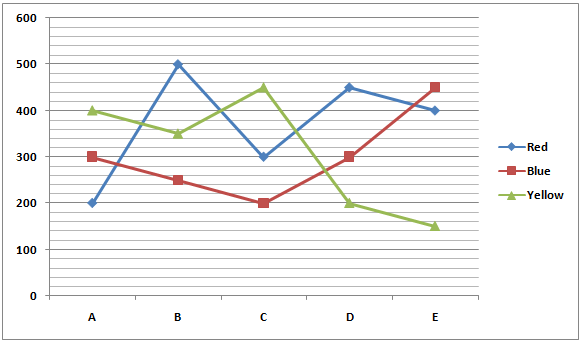
Q. The number of red shirts in A, C and D together is what percent of the number of yellow shirts in B, D and E together?
Study the following information carefully and answer the questions given below.
The given line graph shows the number of three different color shirts in five different shops.

Q. If the total number of shirts in F is 15/19 of the total number of shirts in C and the ratio of the number of red, blue and yellow shirts in F is 4:6:5, then the number of yellow shirts in F is what percent of the number of yellow shirts in A?
Study the following information carefully and answer the questions given below.
The given pie chart shows the percentage distribution of the number of population five different states in 2019.
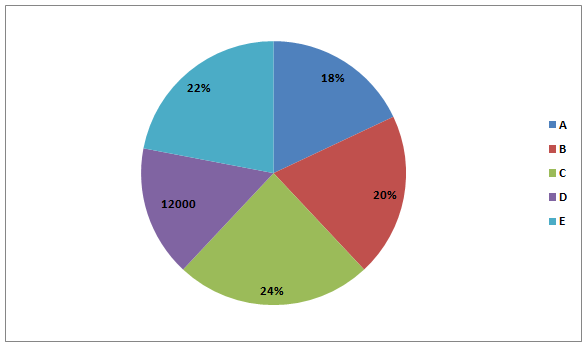
Q. If the number of population in A in 2020 is increased by 40% and the ratio of the number of male and female population in A in 2020 is 5:4, then find the number of female population in A in 2020?
Study the following information carefully and answer the questions given below.
The given pie chart shows the percentage distribution of the number of population five different states in 2019.

Q. Ratio of the number of male and female population in D and E in 2019 is 5:3 and 8:7 respectively. Find the average number of male population in D and E in 2019?
Study the following information carefully and answer the questions given below.
The given pie chart shows the percentage distribution of the number of population five different states in 2019.

Q. The number of male population in C in 2019 is 40% of the total number of population in B in 2019. Find the ratio of the number of male and female population in C in 2019?
Study the following information carefully and answer the questions given below.
The given table shows the % of the number of boys and number of girls in 2011 in five different schools and the number of boys in 2012 with respective schools.
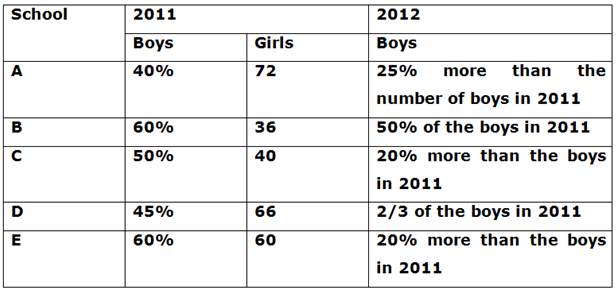
Q. The number of boys in A in 2011 is what percent of the number of boys in D in 2012?
Study the following information carefully and answer the questions given below.
The given table shows the % of the number of boys and number of girls in 2011 in five different schools and the number of boys in 2012 with respective schools.

Q. Find the total number of students in B in 2012 (boys) and 2011 (girls and boys)?


